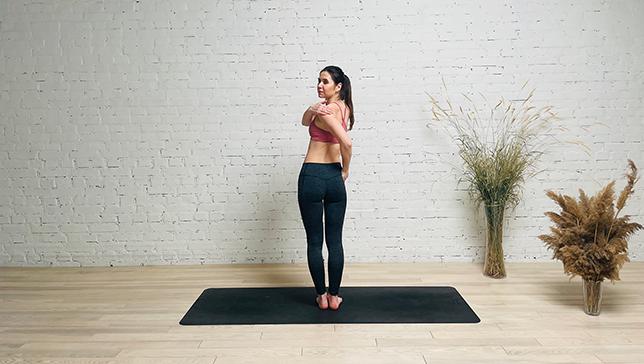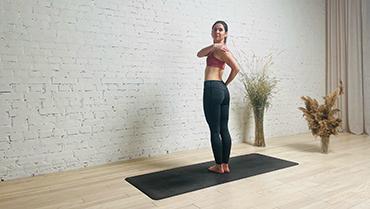Standing Spinal Twist B - Katichakrasana B

Contents
Standing Spinal Twist B or Katichakrasana B (Ka-Ti-Chak-Raah-Suh-Nuh) is a yoga pose that helps to improve flexibility and mobility in the spine while strengthening the legs, hips, and core muscles.
‘Kati’ means the waist, ‘chakra’ stands for the wheel or rotation, and ‘asana’, as you know, is posture. This well-structured routine aims to trim down excess fat around the waist and the lower abdomen.
Traditionally, Katichakrasana is believed to activate and balance the Manipura (solar plexus or navel) chakra because of the twisting of the abdominal region. Opening the Manipura chakra is believed to promote transformative power and energy, boost self-esteem, and encourage self-control, confidence, decision-making, and a sense of purpose.
Pose Detail
- Difficulty: Beginners
- By Type: Chest Opening Yoga Poses, Restorative Yoga Poses, Shoulder Opening Yoga Poses, Strengthening Yoga Poses
- Body Position: Standing Yoga Poses, Twist Yoga Poses
- By Benefit: Yoga Poses For Neck Pain, Yoga Poses For Stress Relief
Step-by-Step Instructions
Benefits and Contraindications
Releases tension in the muscles around the spine
Improves posture
Deepens the breath, especially in the side of the chest
Stretches the psoas
Engages the arms and shoulders
Aids digestion and stimulates kidney function
Stimulates the abdominal organs
Hernia or slip disc
Chronic spinal disorders.
Abdominal surgery recently.
Pregnancy
Photo poses in different angles

Modifications and Props for Beginners
- You can use a yoga block or a folded blanket to support your hand that is placed on your hip.
- You can use a yoga strap or a towel to help you reach your hands to your shoulders if you have tight shoulders.
Useful Tips
- Engage your core muscles throughout the pose to support your spine and maintain your balance.
- Keep your knees soft and your feet grounded to maintain stability and prevent strain in the knees.
- Move into the twist from your waist, rather than just rotating your shoulders, to ensure that the twist is coming from your spine.
- Avoid over-twisting or forcing your body beyond its natural range of motion. Always listen to your body and practice with awareness and mindfulness.
- If you experience any discomfort or pain, release the pose and consult with a qualified yoga teacher or healthcare professional.
Frequently Asked Questions
The frequency of your Katichakrasana practice will depend on your individual needs and goals, as well as your level of experience and comfort with the pose. It can be incorporated into a daily or weekly yoga practice, or used as a warm-up or cool-down for other physical activities. It’s important to listen to your body and practice in a way that feels safe and sustainable for you.
Variations
- Standing Spinal Twist
- Standing Side Stretch Pose
- Standing Twist Straight Arms